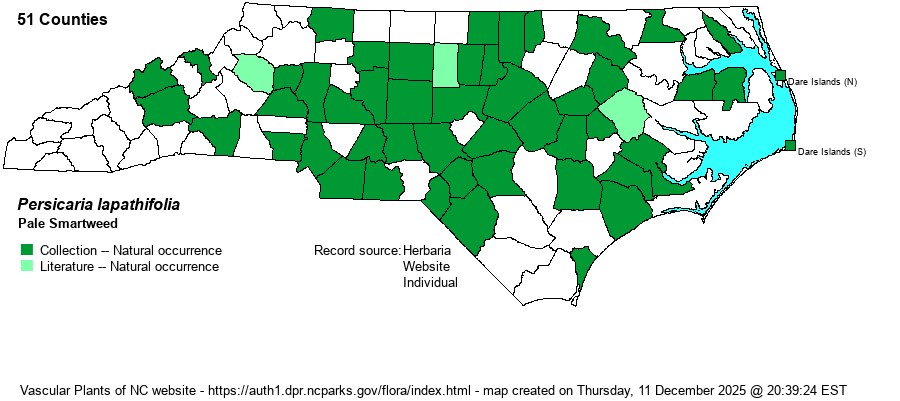| Author | (L.) S.F. Gray | |
| Distribution | Scattered across the state; the gaps shown in the map will mostly be filled in with additional fieldwork. Perhaps truly absent in some Mountain counties.
Apparently nearly cosmopolitan and throughout the New World. | |
| Abundance | Fairly common to locally common in the central and eastern Piedmont; infrequent to fairly common in the Coastal Plain, western Piedmont, and low Mountains. Apparently much suitable habitat between populations, but as with nearly all Persicaria species, it may occur in dense stands (not always!). The NCNHP's State Rank of S3 is woefully conservative; S4 is a better rank, and S5 is not out of the question. | |
| Habitat | Generally in wetlands, such as marshes, pond margins, ditches, and other wet ground. Can occur in weedy places, such as damp fields, wet thickets, trash heaps, etc. Not nearly as restricted to rather pristine marsh/pond margin habitats as are most others in the genus. | |
| Phenology | Flowering and fruiting June-November. | |
| Identification | This tall and rather robust species (up to 4.5 feet) has narrowly lance-shape leaves tapered to a point, generally longer and/or narrower than in similar species. Its inflorescences --- several inches long but quite narrow spikes -- are mostly curved or arcing, not often straight and stiff like some other species. Sepals are pale pink or whitish, petals white. The ocreae usually lack bristles, but some plants may have them up to 0.5 mm. Dense-flower Smartweed (P. densiflorum) also tends to lack bristles on the ocreae; its spikes are usually thicker and more stiff, not gracefully arcing, and usually pinker in color. Despite it often occurring in moist, weedy places -- this species is rather elegant, fairly tall and with numerous narrow white, densely-flowered spikes that gracefully curve downward. | |
| Taxonomic Comments | Often still named as Polygonum lapathifolium.
Many species formerly treated in the genus Polygonum have been moved to Persicaria, the smartweeds. These are generally erect and tall plants with terminal and axillary floral spikes; most occur in wetlands. Others remain in Polygonum, the knotweeds, which are generally prostrate to ascending and with inconspicuous axillary flowers. They occur mostly in dry soils and tend to be weedy.
Attention must be paid to the small collars at the junction of the main stem and leaf stems (called ocreae) and whether they possess terminal hairs or bristles. Some keys also refer to the even smaller collars from which flowers emerge (called ocreolae). Another important ID character is the surface of the greenish sepals -- whether smooth or dotted with indentations (punctate). | |
| Other Common Name(s) | Curlytop Knotweed, Dock-leaved Smartweed, Pale Persicaria | |
| State Rank | S3 [S4] | |
| Global Rank | G5 | |
| State Status | | |
| US Status | | |
| USACE-agcp | FACW link |
| USACE-emp | FACW link |

